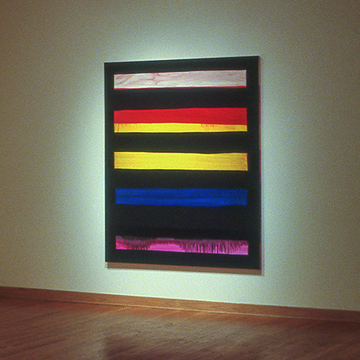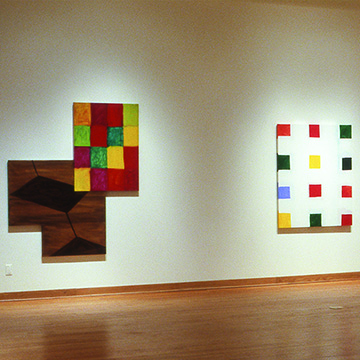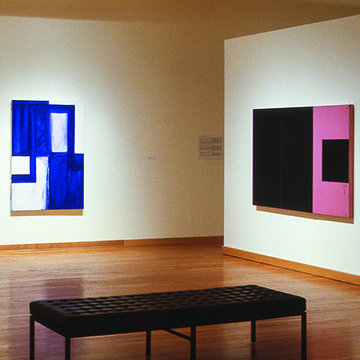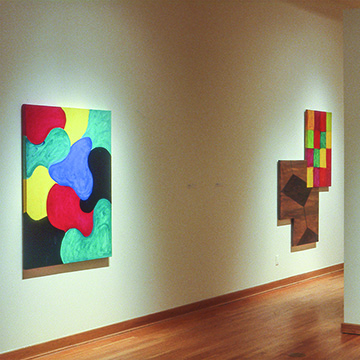Mary Heilmann
This exhibition traces Heilmann's development over the past two decades from minimalist-inspired painting to a more subjective content. Heilmann's early career as a ceramicist – she studied with Peter Voulkos in Berkeley – and sculptor was an important point of departure for her paintings in with process played a vital role.
"My painting has always been tactile. Early acrylics were actually made with my hands. I saw paintings as objects, not pictures, and have always been as interested in the edges as the surfaces – in the scale as in the image.”
Within the simple structure of her minimalist-inspired geometric compositions, Heilmann loads her paintings with an extravagant array of possible meanings – from the lyrical to the crass and vulgar – through her use of keyed up, often unexpected combinations of color. A pink and black painting from 1979 instantly recalls new wave fashion of the late 1970s, but the pink also inevitably suggests a frilly little-girl innocence. Psychedelic Serape, 1983, not only clearly identifies the minimalist grid with Mexican blankets, but through a choice of lush colors ranging from earthy reds to high-key yellow and seductive pinks suggests romantic sunsets and travel adventure. In Slice, 1998, which is dissected by architectural lines and decorated with polka dots, mint green evokes the walls of a ‘50s vogue kitchen or the color of a cocktail.
Large "spots" or splashy drips appear in many paintings and are sometimes loose and metaphoric, sometimes fine and focused.
David Pagel, critic and curator, Los Angeles, has written, "More than any other painter working today, Mary Heilmann can make a quickly flicked drip, a loosely brushed smudge or a solitary dollop of color seem like a big event."
Making allusions to phenomena such as popular culture and literature, landscape and domestic interiors, fashion, music and film, Heilmann's paintings have, as the artist herself says, " ... a sense of time and place ... past time and place, future time and place ... each painting evoking memory and premonition at once." A Heilmann painting can conjure up a moment in a title or in a combination of colors. A work titled Au Go Go might recall a well-known night club; one titled Mint Serape a Mexican artifact; or Woody's Truck Stop an actual experience or the notion of place.
The exhibition gallery guide features the essay "Heilmann's Everyday Pageantry (or, it's easy to be a hedonist if discipline is among your loves)" by David Pagel, critic and curator, Los Angeles.
Mary Heilmann was born in 1940 in San Francisco, California. She earned a BA from the University of California, Santa Barbara, in 1962, and an MA from the University of California, Berkeley, in 1967. Heilmann's work has been exhibited widely in the United States and Europe, and she is represented in numerous public and private collections. Additionally, her work has influenced a generation of younger artists, including Jessica Stockholder, Polly Apfelbaum and Moira Dryer.






